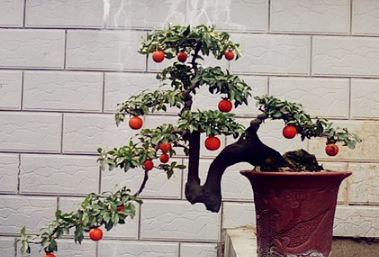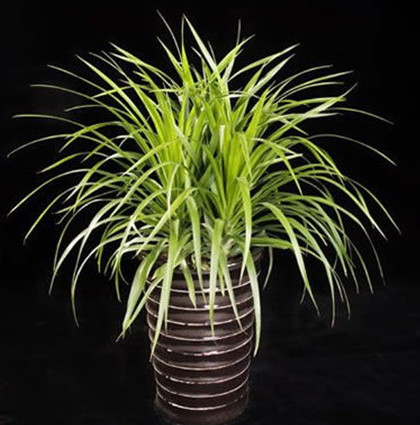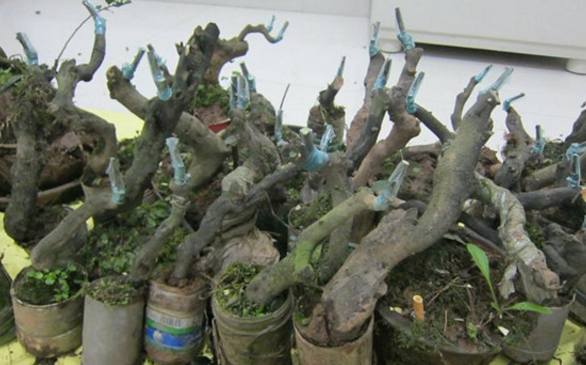Propagation, cultivation and management of bonsai with rare hanging fruit and golden marbles
Golden marbles is a very festive hanging fruit, especially every year from New Year's Day to the Spring Festival, hanging fruit golden marbles in the green leaves from green to red, red and green, dried iron Qiu branches, full of vitality. Then follow in the footsteps of the editor to learn about the golden marbles!

1. Differences in origin and varieties of golden marbles
Golden marbles are distributed and cultivated in East China, South China and Central China. Now listing and participating in the exhibition are mainly golden marbles in Sichuan and Hubei, but the golden marbles in the two places are different.
There are many small fruits of golden billiard leaves in Sichuan, as long as they reach the cultivation age, very small pile heads (small, miniature bonsai) can also hang fruit in the basin.
Hubei golden billiard is divided into big leaf, middle leaf and leaflet, big leaf fruit is small, middle leaf fruit is big, small leaf fruit. Some small pile heads have been cultivated for many years and rarely blossom and bear fruit. Hubei Province has the largest golden marbles, especially without falling leaves in winter.
2. How to identify the dioecious plants of golden marbles
Because golden marbles are dioecious, there are two kinds of potted golden marbles: hanging fruit and not hanging fruit.
From the analysis of tree shape, trunk skin color, leaf shape, leaf color and leaf vein, we can not accurately determine the male and female of the stump. Only by observing the flowers of golden marbles can we accurately distinguish between male and female.
The male plant blossoms with more than two flowers under each leaf bud, the flower is like a small lantern, the pedicel is claw-free, and the flower opens with male stamens and pollen.
The female plant has only one or two flowers under each leaf bud, which is larger than the male flower. The four-leaf flower claw wraps the flower heart as a triangle. After blooming, the flower claw opens like a persimmon flower, and young fruit can be seen inside the flower.
3. Propagation, cultivation and management of golden marbles.
To sow and reproduce:
After the fifteenth day of the first lunar month, pick the ripe fruit, wash the seeds and dry them.
Soak it in about 30 ℃ of hot water for 48 hours in early April and cover it with double gauze in a leaky container. Like long bean sprouts, pour water on the seed once a day until the seed opens and germinates, and then sow it on the prepared seedbed.
After routine management, seeding seedlings can be used to make small bonsai after three years.
Cutting propagation:
Cutting with female branches, whether it is the new branch or the old branch can be cut alive. The key to insertion is to pay attention to the season, that is, the middle of April every year.
Secondly, it is necessary to ensure the moist environment of the inserting bed and the freshness of the cuttings. If there are conditions, you can put the inserting bed in an all-sunshine place, spray it during the day and stop at night.
If there are no conditions, the cutter can be placed in an open, ventilated, half-yin and half-yang place, and spraying with a sprayer four times a day can ensure the survival of marble cuttings. Use cuttings to make small bonsai and hang fruit after three years.
4. Dig up the old pile in the mountain field
From November of the first year to April of the following year.
Under the premise of protecting the natural ecological environment, professionals can dig up the mountain in a planned way.
The old pile down the mountain is soaked in clean water for two hours, and then the pile head is deeply buried with sand to pour through the fixed root water. after that, as long as the environment is moist, the branches can grow to one meter, and the next March can be dug up, trimmed, and shaped, and it will become a pot of tree stump bonsai in three to four years.
5. Routine maintenance and management
The shape of the golden marbles can be shaped with wire to shape the trunk and main branches. The future management will be dominated by pruning and hanging as a supplement.
The upper basin can be prepared with the proportion of river sand, rotten leaf soil and loess at 4:4:2, watered once after planting, and maintained in a cool place for half a month, it can be managed normally.
After the new buds are sent out, the rotten fertilizer liquid is irrigated once a month, and the ratio of fertilizer liquid to water is 1:10, so as to apply more fertilizer in spring and autumn, less in summer, and no fertilizer in winter.
Watering should make the basin soil wet and water thoroughly every night in summer. In spring, autumn and winter, if the basin soil is not dry or irrigated, it must be watered thoroughly.
6. Fruit culture
Because golden marbles are dioecious, it is necessary to try to make male plants blossom next to female plants during flowering, so as to naturally pollinate and improve the rate of hanging fruit.
If no male plant blossoms next to the female plant, artificial pollination can be carried out. When the female plant has fallen, the fruit has been hung on the pedicel, at this time, it can be sprayed twice every half a month to increase the fruit setting rate.
In the ninth month of the lunar calendar, urea water can be sprayed twice to make the fruit big and shiny.
The golden marbles cultivated and managed in this way, from October to February of the following year, have luxuriant branches and branches of red fruit, which can give people a sense of harvest, joy, peace and beauty.
Rare hanging fruit golden marble bonsai golden marble, scientific name Diospyrosarmata, alias bottle orchid, thorn persimmon, bottle orchid, persimmon family persimmon semi-evergreen or evergreen shrub. The golden marble stem is strong and straight, natural Qiu qu, color such as iron, suitable for making stump bonsai. The golden marble blossoms in April, the flower is shaped like a bottle, fragrant and orchid, so it is also called "bottle orchid"; after flowering in May, the green fruit becomes orange or orange, shaped like a bullet, so it is called "golden marble". The fruit lasts for a long time until the next spring; the leaves are dark green and leathery: they are ornamental flowers with beautiful fruits, flowers and leaves. The stump bonsai of golden marbles is of high economic value. 1. Differences in origin and varieties of golden marbles are distributed and cultivated in East, South and Central China. Now the golden marbles in Sichuan and Hubei are mainly listed and exhibited, but the golden marbles in Sichuan are different. There are many small fruits in Sichuan. As long as they reach the cultivation age, very small pile heads (small, miniature bonsai) can also hang fruit in the basin. Hubei golden billiard is divided into big leaf, middle leaf and leaflet, big leaf fruit is small, middle leaf fruit is big, small leaf fruit. Some small pile heads have been cultivated for many years and rarely blossom and bear fruit. Hubei golden marbles are the largest, especially without falling leaves in winter. every year from New Year's Day to the Spring Festival, hanging fruit golden marbles change from green to red in the green leaves, red and green, dried iron Qiu branches, full of vitality. Second, how to identify the dioecious plants of golden marbles because of dioecious plants, there are two kinds of potted golden marbles: hanging fruit and not hanging fruit. After years of observation and research, the author can not accurately determine the male and female of the tree stump from the analysis of tree shape, trunk skin color, leaf shape, leaf color and leaf vein. Only by observing the flowers of golden marbles can we accurately distinguish between male and female. The male plant blossoms with more than two flowers under each leaf bud, the flower is like a small lantern, the pedicel is claw-free, and the flower opens with male stamens and pollen. The female plant has only one or two flowers under each leaf bud, which is larger than the male flower. The four-leaf flower claw wraps the flower heart as a triangle. After blooming, the flower claw opens like a persimmon flower, and young fruit can be seen inside the flower. 3. Reproduction, cultivation and management of golden marbles 1. Sowing and reproduction: after the fifteenth day of the first lunar month, the ripe fruits are picked, and the seeds are washed and dried. In early April, after soaking in hot water for 48 hours or so, they are picked up and placed in a leaky container and covered with double gauze. Like long bean sprouts, pour fresh water on the seeds once a day until the seeds open and germinate, and then sow it on the prepared seedbed. After routine management, seeding seedlings can be used to make small bonsai after three years. 2. Cutting with female branches, no matter the new branches or the old ones, can be cut alive. The key to inserting work is to pay attention to the season, that is, the middle of April. Secondly, it is necessary to ensure the moist environment of the inserting bed and the freshness of the cuttings. If there are conditions, you can put the inserting bed in an all-sunshine place, spray it during the day and stop at night. If there are no conditions, the cutter can be placed in an open, ventilated, half-yin and half-yang place, and spraying with a sprayer four times a day can ensure the survival of golden marble cutting skills. Use cuttings to make small bonsai and hang fruit after three years. 3. Dig up old piles in the mountains: from November to April of the following year. Under the premise of protecting the natural ecological environment, professionals can dig up the mountain in a planned way. The old pile down the mountain is soaked in clean water for two hours, and then the pile head is deeply buried with sand to pour through the fixed root water. after that, as long as the environment is moist, the branches can grow to one meter, and the next March can be dug up, trimmed, and shaped, and it will become a pot of tree stump bonsai in three to four years. 4. Routine maintenance and management. The shape of the golden marbles can be shaped with wire to shape the trunk and main branches. The future management will be dominated by pruning and hanging as a supplement. The upper basin can be prepared with the ratio of river sand, rotten leaf soil and loess at 4:4:2, pour water once after planting, and keep it in a cool place for half a month, then it can be managed normally. After the new buds are issued, the rotten fertilizer liquid is poured once a month, and the ratio of fertilizer liquid to water is 1MUMAL 10, so as to fertilize more in spring and autumn, less in summer, and no in winter. Watering should make the basin soil wet and water thoroughly every night in summer. In spring, autumn and winter, if the basin soil is not dry or irrigated, it must be watered thoroughly. 5. Hanging fruit culture: because golden marbles are dioecious, it is necessary to try to make male plants blossom next to female plants during flowering, so as to naturally pollinate and improve the rate of hanging fruit. If no male plant blossoms next to the female plant, artificial pollination can be carried out. When the female plant has fallen, the fruit has been hung on the pedicel, at this time, it can be sprayed twice every half a month to increase the fruit setting rate. In the ninth month of the lunar calendar, urea water can be sprayed twice to make the fruit big and shiny. The golden marbles cultivated and managed in this way, from October to February of the following year, have luxuriant branches and branches of red fruit, which can give people a sense of harvest, joy, peace and beauty. Responsible Editor: Bahua Valley
- Prev

Is the dragon blood tree poisonous? can you keep it at home? what are the reasons for yellowing leaves?
Dragon blood tree, also known as the tree of blood, blood-activating holy medicine, plant birthday. It is the precious Yunnan red medicine Draconis Draconis, also known as Qilin Draconis, which is as famous as Yunnan Baiyao. Li Shizhen is praised as a holy medicine for promoting blood circulation in the Compendium of Materia Medica. So is this plant poisonous in the end? Let's get to know it.
- Next

How much is the grafting technique of golden marbles?
Golden marbles are dioecious, and many flower friends must have tried grafting with branches or buds but failed, but there are certain skills. The grafting technique of golden marbles the grafting time of golden marbles in early May is the best time for grafting of golden marbles. Grafting techniques of golden marbles
Related
- Fuxing push coffee new agricultural production and marketing class: lack of small-scale processing plants
- Jujube rice field leisure farm deep ploughing Yilan for five years to create a space for organic food and play
- Nongyu Farm-A trial of organic papaya for brave women with advanced technology
- Four points for attention in the prevention and control of diseases and insect pests of edible fungi
- How to add nutrient solution to Edible Fungi
- Is there any good way to control edible fungus mites?
- Open Inoculation Technology of Edible Fungi
- Is there any clever way to use fertilizer for edible fungus in winter?
- What agents are used to kill the pathogens of edible fungi in the mushroom shed?
- Rapid drying of Edible Fungi

